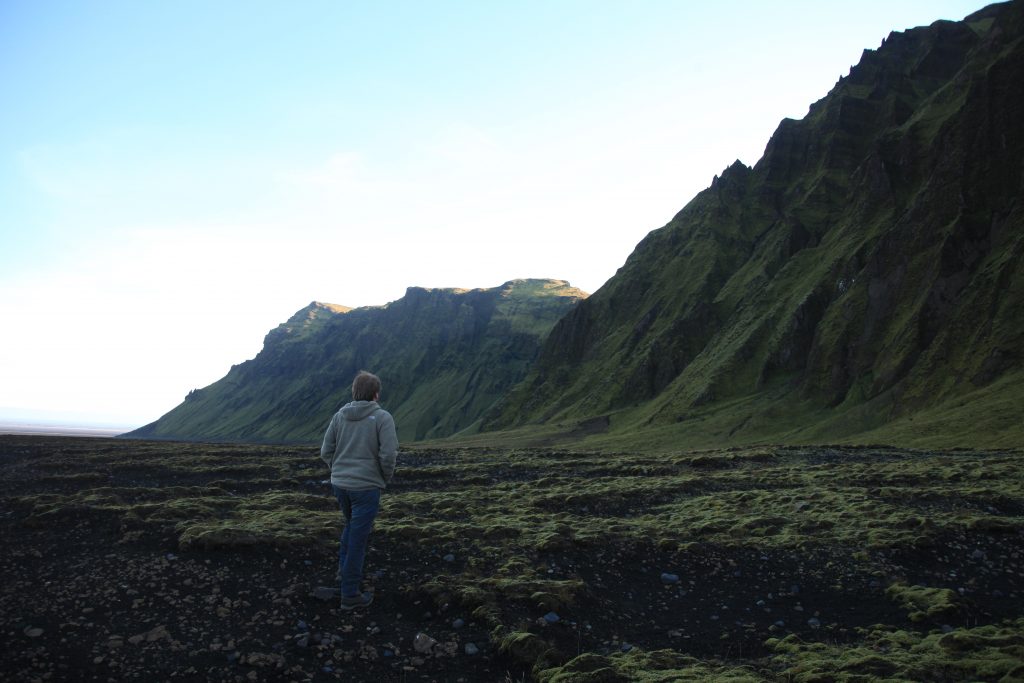
Join Gareth Edwards and the Publicity Group at Industrial Light & Magic as we look back at his time directing Rogue One: A Star Wars Story. Gareth discussed the cutting-edge virtual production used for the film, and the ways in which George Lucas inspired him as a filmmaker.
Tell me about the freedom you found in the virtual production-aspects of Rogue One?
John Knoll was very crucial for this, because he and the team at ILM devised a virtual environment where we could go in and look for shots. My entryway into filmmaking was through visual effects, so I understand it a bit, but a lot of VFX is kind of dark arts, which causes clients to come to visual effects companies and see VFX as magic, because no one understands what they do. The downside to that is that they can ask for things or approach scenarios in such a way that is really back-to-front, and doesn’t produce the best result. I find that storyboarding shots is really useful, but at a certain point it becomes somewhat limiting, because you’re having to invent every single detail about that shot. Whereis, in the real world, what you tend to do is you have a space, because it already exists. The light hits objects in this space a certain way, and going in, you knew you’d do a close up of someone’s face, but if you were to have them look down a little bit, and maybe move to the right, suddenly you have this beautiful composition that you wouldn’t have found with storyboarding. The trick with VFX is having that opportunity, and going, “this was the plan, but now that the ingredients are here in front of us, doing this would actually be better.” So figuring out a seamless way to do that without it being painful for the artists is important. There’s lots of ways to achieve that, but when you’re in space with spaceships, the only real way to do it—unless you’re doing what George did, which was taking footage of WWII aerial combat that would represent the final shot—is what John Knoll and Industrial Light & Magic were pushing for.
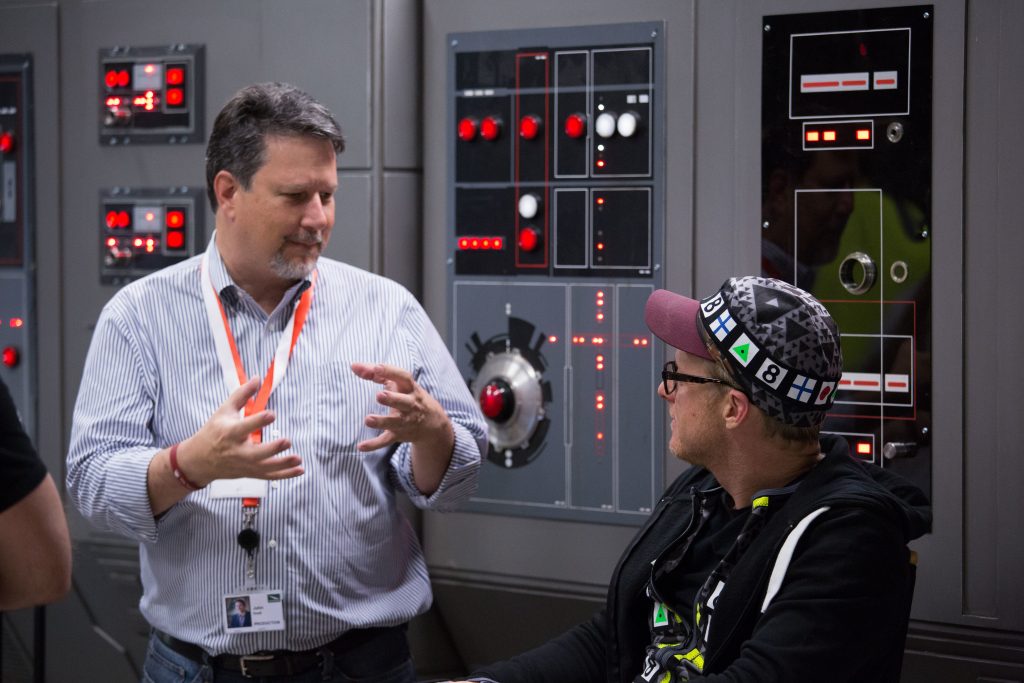
And what was John pushing for?
It was pre-viz animation of each section of the battle sequence. They then figured out a set up where they had an Apple iPad, with a game controller attached to it. When you moved the iPad, it could tell where it was in 3D space. They would then just loop these twenty or thirty-second chunks of animation, and I would get to hang out in these spots and just film it again and again, generating hours of footage. Then I’d go home on my MacBook and select my favorite takes, and then try to cut something together. It would be very jittery, and handheld, and not perfect. For each one we’d smooth it out by filming from another spaceship, and for another we’d keep some of that handheld-look. It felt like the process of getting those virtual shots was how we were getting the live action shots, which was, “light a space and find the shot,” versus, “tell us the shot, and we’ll invent all the pieces to create it.” It always feels more real with the first approach.
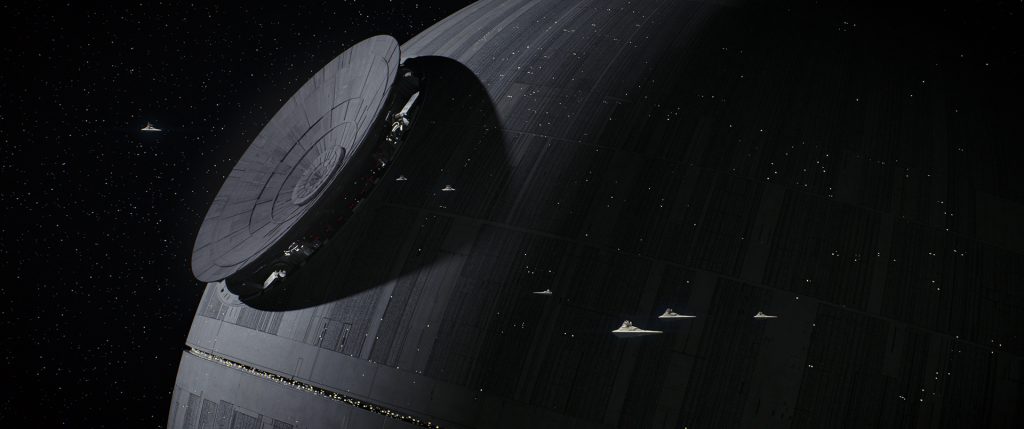
Like that shot of the Star Destroyer emerging from the shadow of the Death Star.
Exactly. That was a great example of John Knoll and ILM pushing for this new technology. If I remember correctly, we needed a shot of the Death Star for the trailer, but they needed it in only a few days. I remember that John got the iPad, and set up a model of the Death Star and some Star Destroyers. The important thing when devising a shot like that, is that the idea of scale is only relevant to something bigger in the shot. A typical thing you do in matte paintings, is when something needs to look really big, you paint a little human in there. It’s a trick that they used to great effect in The Empires Strikes Back. When you want something to feel big, you need to set something up to feel really big, and then show a new thing that’s even bigger than that. The idea was to have a ship that you know the scale of, like a TIE fighter, and then reveal the Star Destroyer, which feels huge, and then you reveal the Death Star which feels impossibly massive. I remember asking them, “can you do real-time shadows on this?” Once I learned that that was possible, it became so fun to reveal and conceal the ships in shadow, and find that moment where the dish slides into place. Within a few hours, we had the shots that went into the trailer, and that never would have been possible without the real-time technology that ILM was using.

Since Rogue One, you’ve gotten to visit ILM’s StageCraft volume in person. Having that experience, did it make you think about how you may have captured any shots differently?
I think that’s always true of technological advances in filmmaking, so yes. For sure. It feels like filmmaking in general is an archaic process. It’s over a century old, and in some ways, it hasn’t changed hardly at all – and yet this digital revolution, which is happening all around us, should drastically change the ways we make movies, but it’s been a slow process. There is so much we could do to utilize the technology we have to be more creative, and allow us to do things we couldn’t have done before. StageCraft though is a massive leap. It’s game-changing. It’s moving the industry forward.

What do you think will stay the same?
Storytelling, regardless of the medium. From the time of early humans, a million years ago until today, we have an innate need to sit around a campfire and listen to a story. Whether it’s a story about something interesting that happened that day, theorizing about why the world is the way it is. It’s absolutely hardwired into us. There’s this little glowing light. The need to paint a picture or sing a song about another person or another place. I don’t believe that that is going away anytime soon. We’ll always have an appetite for storytelling. Strangely, what I find funny is that a movie is around two hours long, and that’s about the length of time it takes for a campfire to burn out. It’s so embedded in us. That’s what cinema is, it’s us being able to dream out loud, or watch another person’s dream in real-time. I hope that stays with us. I hope in five-hundred years, people are still watching Star Wars.
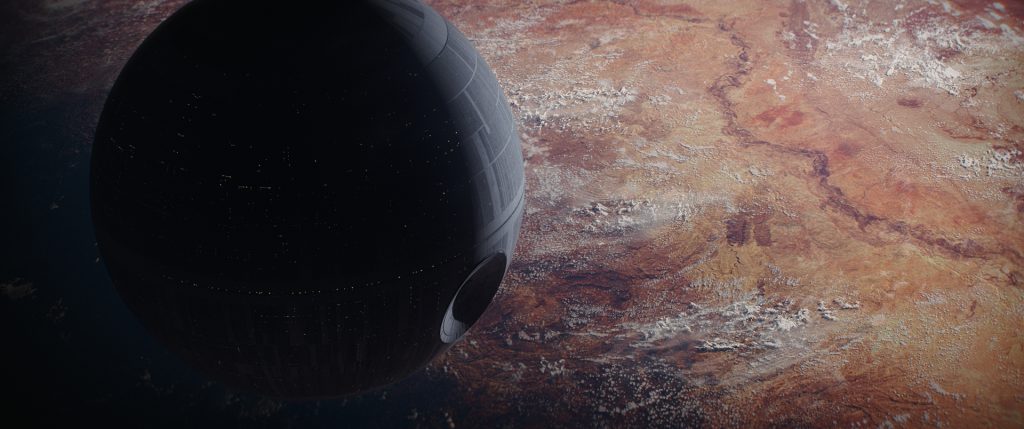
In getting into the making of film and working with Lucasfilm and Industrial Light & Magic, were there ever moments where you needed to pinch yourself, because you were given the ability to create nearly anything you could dream up?
Funny enough, it almost felt like we had too much power, so we needed to be careful that we limit ourselves so it felt like the original trilogy. One of the early things that we did with John Knoll and ILM was the kitbashing, using the original models just like the original films. We went and bought some of the original model kits, lots of WWII, vintage-collector stuff. We started scanning those model parts in so that we could stick them onto the models we were building. What’s interesting is the subsurface scattering that goes on with those model pieces. It’s not like metal. So we were trying to recreate that model kit feeling on our ships. What’s funny though, when you get into that scenario, you realize that your memory is a little bit better than reality with some of the sets and props. The golden rule became, “let’s not do it how it was, let’s do it how we remember.” We wanted it to look and feel like how you “thought” those models looked. Also, going through the Lucasfilm Archives, the models are everywhere, and there were some designs in there that looked really cool. Those were good keys for us, because we were making something before A New Hope, but what did that mean, stylistically? Doug Chiang had a really hard task before all of us while doing Star Wars: Episode I – The Phantom Menace. They took a real leap on that film from both a timeline and stylistic standpoint. It was much more Art Deco. The streamlined nature of the ships felt much more like The Rocketeer and Flash Gordon; those types of serials that inspired George Lucas to make Star Wars in the first place. And that makes sense because it takes place over 30 years before A New Hope. But for us, aesthetically, it was just before A New Hope, yet we still wanted it to feel distinct. What we did for inspiration, is we looked at the Ralph McQuarrie artwork, and the early models that had been made for A New Hope; things that had been either abandoned or improved. We sort of “reversed the car” back into that space, and where they went left, we went right. One example is that really slender, aspirational Stormtrooper that Ralph painted. He made that without a care in the world about how it would be actually realized by the costume department. We kept pointing at that, because traditionally when you put someone in armor, it can start to feel a bit bulky. We wanted something that looks like it could sprint and cause some serious damage. We tried to make armor that was slightly bendable, so it could sit just over top of the skin. We tried to cast towards that look of the troopers, someone tall and lanky. What that eventually became was the Death Trooper. That’s where the Death Troopers started. To answer your original question, we tried not to be kids in a candy store, we tried to temper that and work off the design language that existed. “With all of those limitations, what would they have done?”

Did you and Greig Fraser try to match some of the old-school camera moves seen in the original trilogy?
We did. We tried to keep the vocabulary of any shots featuring Krennic and the Empire the same as those old school cinematographers. The way when someone walks by, how they would push in again to recompose based on the new position of the actors. All of these little things that would happen that were common in the late 1970s, things we don’t do so much now.

This year being the 50th anniversary of Lucasfilm, I wanted to know what George Lucas means to you?
A lot of things come to mind. As crazy as it sounds, I think he’s underrated. I know that sounds crazy with all of his accolades. When I was a little kid, I didn’t ever really watch THX 1138 or American Graffiti. But as I got older, I would revisit those films constantly. THX is an incredible debut. It’s just an absolutely fantastic film, and one of the strongest films that came out of a first-time filmmaker in all of cinema. In terms of how bold and completely brand new it was. So many things made their way to Star Wars too. That fuzzy comms chatter. The clinical corridors. The look and feel. There was no Ralph McQuarrie, but it felt so much like George. He has such a great aesthetic and an amazing eye. It took a lot for him to make that film. Then he goes and makes the films that have inspired you, and me, and everyone like us. Even if that was all he ever did, it would have been enough. But then he goes and pushes harder, and pushes the digital technology further. Because of him, I was able to make my first film on a digital camera. I wouldn’t have been able to make my first film if it required film stock. I wouldn’t have been able to make my first film without George. Him pushing HD, and all the work he did with the technology used for the prequels, and the digital camera technology. I got into digital effects because of that, and I wouldn’t have been able to if it wasn’t for George building up everything at Industrial Light & Magic. He inspired me to want to become a filmmaker, and he gave me the tools to do it. At the end of that journey, I got to make a Star Wars film. He gave me Rogue One.

Have you gotten to spend time with him?
A handful of times. This next story I say with the utmost love and admiration for the entirety of the Star Wars catalogue. But when I had my office at Pinewood, I was putting a lot of pressure on myself to make this film. Everyone had The Empire Strikes Back, and A New Hope posters in their offices. To help elevate that, and to remind myself that this was Star Wars, and that I was making a Star Wars spinoff film, and I needed to have fun, I put up framed prints from The Holiday Special and Caravan of Courage: An Ewok Adventure. Those were the first spinoff films. [laughs]. Well, one day, George came to Pinewood, and he was sweet enough to come up to my office. I worked really hard to distract him while we spoke so he wouldn’t see the posters. I was really animated, and tried to lead him through the back. It was like a comedy skit as I tried to keep him away from the posters. I didn’t want him to get the wrong idea about Rogue One. [laughs]. We got to hang out for a few hours that day, and I got to tour him around. I got to spend time with my hero. It was a surreal experience. He’s the Paul McCartney of film.
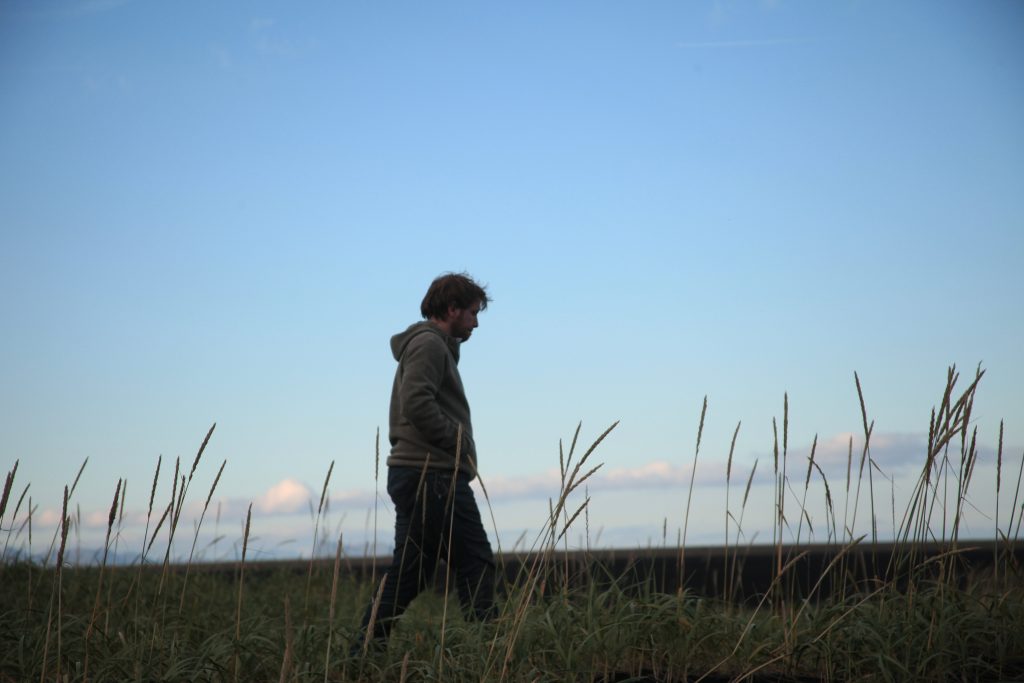
And you got to spend time at Skywalker Ranch, yeah?
Yes. When I was there, the projectionist was so sweet. They said, “ when we would project the Star Wars reels, George would sit right there.” And they pointed over at a seat. “Would you like to sit there?” I got to sit there throughout the sound mix on Rogue One. It felt like I was sitting on the throne of the film world. The funny thing is, if you’re so intimidated by it, it can paralyze you. You have to let that fall away. But let me tell you, that was the best job in the world. That beautiful drive through the trees and hills on the way to Skywalker Ranch. Past Lake Ewok. It was so utopian. We were making a Star Wars movie. It was everything I’ve ever dreamed of. It’s surreal to think it even happened to begin with. You dream about this stuff as a kid, but it shouldn’t actually happen. What’s funny is, when it comes to Industrial Light & Magic, and Lucasfilm, and the team at Skywalker Sound, you see it in everyone that works there. We all have the same story. You and me, we grew up with the same story. The trinkets on your desk are the same ones I have at home. Those Ralph McQuarrie prints behind you. I feel like we all have a lot in common. I feel like if I was going to hang out with people outside of work, it would be with the people at ILM. Everyone is a mini-filmmaker, and even though we grew up in different places all around the world, if we went to the same school as kids, we’d be mates – and then suddenly all of these people wound up at Skywalker Ranch & Industrial Light & Magic. When Covid is through, I hope everyone can come together and see each other again.

I love that. Last question. John Knoll and Hal Hickel wanted me to ask you about Area 51?
[Laughs]. So I was in Las Vegas watching John Knoll, Hal Hickel, and Matthew Wood, from Skywalker Sound, during a panel at NAB for Star Wars. After it was through, I told them all, “we are only a few hours away from Area 51. We will never get this chance again.” [Laughs]. We drove several hours in the dead of night, through Rachel, Nevada, and walked right up to that fence where you couldn’t go any further. We went to Area 51. We stayed just long enough to scare ourselves, and then we got out of there.” [Laughs].
